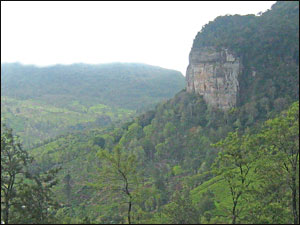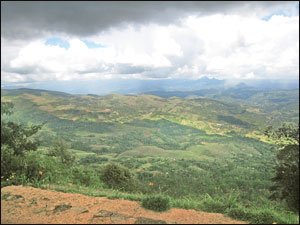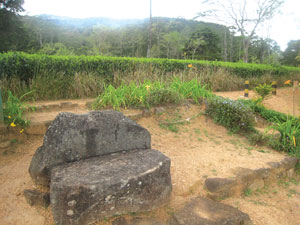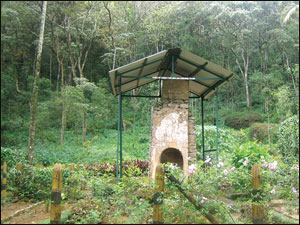|
Camellia Sinensis:
First and last Love
Aditha DISSANAYAKE
I try, but the massive rock, reminiscent of Sigiriya, casting a heavy
shadow on everything around me, remains silent. I know the water gliding
gracefully over the pebbles in the creek is telling me the answers; if
only I could understand her language. “Cheerup. Cherup. Cherup” insists
a magpie from a tree above the water. I hope he is saying “Yes, yes,
yes” to my three questions. Was he handsome? Was he kind? Was he happy
here? “Cherup!”.
 |
|
Silent
monolith |
 |
|
View
from the bench |
I know he would have sat here, on this stone bench, one arm thrown
across the top half of the two stones, legs crossed, head thrown back,
gazing at the scene in front of him, the very scene I am watching now, a
scene that reminds me of ‘Braveheart’, of picture postcards and screen
saving images on the computer. But to him a scene that would have
brought back memories of home. Scotland. I raise my eyes towards the
sky. And suddenly I know, on a day like this when he sat on this bench
at this time of the day, even if everything else around him would have
changed since then, there would have been one constant; the sky. The sky
would have been the same, the same azure with the white clouds drifting
at the same speed they are drifting right this minute. The sky of that
day would have been the sky of today. Sky to sky, we unite.
With this relaization come the answers to my questions. Yes, he was
handsome because his heart was beautiful. Yes, he was kind; kind to
Mother Nature, kind to the workers from India, who like him had left
their beloved motherland, in search of a new life on this strange but
beautiful island.
Yes, he was happy; as happy as any pioneer who had overcome many an
obstacle in creating a settlement in the jungles of Galaha,Kandy could
be. James Taylor was only sixteen when he left Scotland and sailed to
the mysterious, exotic island called Ceylon in 1851. Born on March 29,
1835, he was the son of a modest wheelwright in Kincardineshire,
Scotland.
Having lost his mother at the age of nine, he left behind him five
other siblings when he signed up with G & L A Hadden, the London agents
for Loolecondera Estate, to work for three years as an Assistant
Supervisor on their Coffee plantation in Ceylon. His salary, according
to the information provided in ceylon-tea-portal.com, was 100 Sterling
Pounds a year. On October 22, 1851 he set sail to Ceylon, never to
return home.
‘The Contemporary Tea Time’ journal, states five years after he took
up his post, his employers, Harrison and Leake, impressed by the quality
of his work, put Taylor in charge of the Loolecondera Estate and
instructed him to experiment with tea plants.
The Peradeniya nursery supplied him with his first seeds around 1860.
As if in homage to this young Scotsman who made tea synonymous with
Ceylon, five acres of those first tea bushes are still alive, still
yielding the legendary two leaves and a bud.
Take a walk up a gravel path under the watchful eyes of the silent
rock, caressed by a soft wind creating soothing music as she runs her
fingers through the leaves of the trees above, to reach the remnants of
the log cabin where he had lived and manufactured the first bags of tea,
ever to be made in Sri Lanka.
 |
|
The stone
bench |
 |
|
The
fireplace in the log cabin |
What would life have been like in that log cabin on a cold, windy
night in March? In James Taylor’s own words, “whenever the light went
out at night, a flock of rats from the jungle beside us came in looking
for something to eat; and then the wind, of which we have plenty at this
season of the year, blows a perfect hurricane in the bungalow, sometimes
so as to put out the lamp. This is the rainy season with us and cold
too; I wonder how the naked fellows of coolies can stand it all.”
(Source: A Bean Two Leaves and a Bud, Edouard Rowlands)
Once the bushes had started to yield, he had started making the tea
entirely with ‘arrangements in the bungalow verandah’. One Sunday when
his neighbour, E G Harding from the Great Valley Estate, paid a visit he
had found ‘the factory’ was in the bungalow. The leaf was rolled on
tables on the verandah by hand, from wrists to elbow, while the firing
was done in chulas or clay stoves, over charcoal fires, with wire trays
to hold the leaf. The result was delicious tea which Harding bought for
one rupee and fifty cents a pound.
Though he would have cleared the forest land in the district of
Hewaheta, James Taylor was careful not to cause undue harm to Mother
Nature. The uncleared patches of the virgin forests still visible on the
fields of the Kondagala Division of the Loolecondera Estate are evidence
of his ‘apologies’ to nature for the destruction he had had to instigate
in the name of ‘economic progress’.
To the very last day of his life he lived on the Loolecondera Estate,
leaving his beloved plantation only once. This was to visit Darjeeling,
in 1874,in order to study the new tea plantations in India. By 1872 he
had set up the first tea factory on the island; a rudimentary ‘sack’,
the walls of which were constructed from mud and wattle. Inside was his
very own tea-rolling machine. “I have a machine of my own invention...
for rolling the tea which I think will be successful. If so, we cannot
help making a profit on tea if it grows of fair quality in this
country,” he wrote in a letter dated March 18, 1872. The following year
his first quality teas were sold for a very good price at the epic
centre of tea trading, the London auction in Mincing Lane.
“Taylor trained a number of assistants, and from that point on;
Ceylon tea arrived regularly in London and Melbourne. Its success led to
the opening of an auction market in Colombo in 1883, and to the founding
of a Colombo tea dealer’s association in 1894.” (Source: Contemporary
Tea, Time Vol. X No. 3 September-November 2001). On May 2, 1892, he
breathed his last amidst the fields of tea he had so carefully nurtured.
It took one whole day, for twenty four men changing hands every four
miles, to carry his coffin across the 18 miles from Loolecondera to the
Mahaiyawa cemetery in Kandy.
His people, the Kanganis and the labourers walked behind their ‘Sami
Dorai’ with tears in their eyes. The inscription on his grave reads “In
pious memory of James Taylor, Loolecondera Estate, Ceylon, the pioneer
of tea and cinchona enterprise, who died on May 2, 1892, aged 57 years.”
Today, walking on the very paths he would have trodden, paths which
he had helped build with his own hands, looking at the tea bushes he had
planted, staring at the fireplace in his log cabin and imagining an
evening when it would have blazed fiercely, when he would have stared
into the flames, and pondered on the day-to-day problems of running the
tea estate, it is easy to realize why he had remained a bachelor to the
very last. Camelia Sinensis would have been his first and last love.
[email protected]
|



